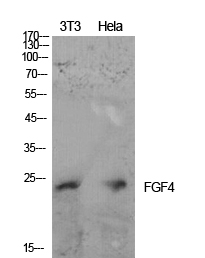FGF-4 Polyclonal Antibody
- Catalog No.:YT5552
- Applications:WB;ELISA
- Reactivity:Human;Mouse;Rat
- Target:
- FGF4
- Fields:
- >>MAPK signaling pathway;>>Ras signaling pathway;>>Rap1 signaling pathway;>>Calcium signaling pathway;>>PI3K-Akt signaling pathway;>>Regulation of actin cytoskeleton;>>Pathways in cancer;>>Chemical carcinogenesis - receptor activation;>>Melanoma;>>Breast cancer;>>Gastric cancer
- Gene Name:
- FGF4
- Protein Name:
- Fibroblast growth factor 4
- Human Gene Id:
- 2249
- Human Swiss Prot No:
- P08620
- Mouse Gene Id:
- 14175
- Mouse Swiss Prot No:
- P11403
- Immunogen:
- The antiserum was produced against synthesized peptide derived from the C-terminal region of human FGF4. AA range:151-200
- Specificity:
- FGF-4 Polyclonal Antibody detects endogenous levels of FGF-4 protein.
- Formulation:
- Liquid in PBS containing 50% glycerol, 0.5% BSA and 0.02% sodium azide.
- Source:
- Polyclonal, Rabbit,IgG
- Dilution:
- WB 1:500 - 1:2000. ELISA: 1:10000. Not yet tested in other applications.
- Purification:
- The antibody was affinity-purified from rabbit antiserum by affinity-chromatography using epitope-specific immunogen.
- Concentration:
- 1 mg/ml
- Storage Stability:
- -15°C to -25°C/1 year(Do not lower than -25°C)
- Other Name:
- FGF4;HST;HSTF1;KS3;Fibroblast growth factor 4;FGF-4;Heparin secretory-transforming protein 1;HST;HST-1;HSTF-1;Heparin-binding growth factor 4;HBGF-4;Transforming protein KS3
- Observed Band(KD):
- 22kD
- Background:
- The protein encoded by this gene is a member of the fibroblast growth factor (FGF) family. FGF family members possess broad mitogenic and cell survival activities and are involved in a variety of biological processes including embryonic development, cell growth, morphogenesis, tissue repair, tumor growth and invasion. This gene was identified by its oncogenic transforming activity. This gene and FGF3, another oncogenic growth factor, are located closely on chromosome 11. Co-amplification of both genes was found in various kinds of human tumors. Studies on the mouse homolog suggested a function in bone morphogenesis and limb development through the sonic hedgehog (SHH) signaling pathway. [provided by RefSeq, Jul 2008],
- Function:
- function:Can transform NIH 3T3 cells from a human stomach tumor (hst) and from karposi's sarcoma (KS3). It has a mitogenic activity.,similarity:Belongs to the heparin-binding growth factors family.,
- Subcellular Location:
- Secreted .
- June 19-2018
- WESTERN IMMUNOBLOTTING PROTOCOL
- June 19-2018
- IMMUNOHISTOCHEMISTRY-PARAFFIN PROTOCOL
- June 19-2018
- IMMUNOFLUORESCENCE PROTOCOL
- September 08-2020
- FLOW-CYTOMEYRT-PROTOCOL
- May 20-2022
- Cell-Based ELISA│解您多样本WB检测之困扰
- July 13-2018
- CELL-BASED-ELISA-PROTOCOL-FOR-ACETYL-PROTEIN
- July 13-2018
- CELL-BASED-ELISA-PROTOCOL-FOR-PHOSPHO-PROTEIN
- July 13-2018
- Antibody-FAQs
- Products Images

- Western Blot analysis of NIH-3T3, Hela cells using FGF-4 Polyclonal Antibody. Secondary antibody(catalog#:RS0002) was diluted at 1:20000



